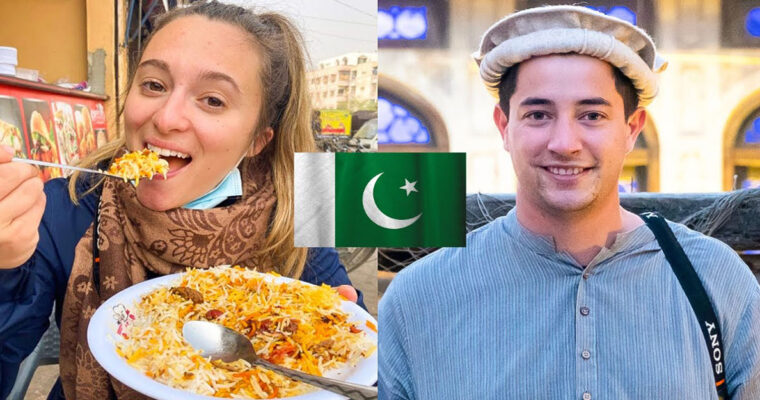The richness of Khaber Pakhtun Kwan’s cuisine is no secret to most desi food lovers. In fact, my regular users are familiar with the fact that all Youtube bloggers that have come to Pakistan to explore Pakistani Cuisine love KPK Cuisine. You can also read our fabulous articles on visitors’ view by clicking here. Let’s talk about the topic! I got a chance of exploring many local Pakhtun dishes during my 2 years stay in Islamabad. I also visited renowned cities of KPK province and taste famous dishes from local food streets. However, I realized Banu Beef Pulao is one of the famous dishes and the people of KPK are in so love with special Banu Beef Pilao. So, I decided to taste the original Banu Beef Pul from Peshawar, when I did that was really amazing experience for me. Honestly speaking, It was one of the best Pilaosof my life. That tasty pulao encouraged me to make a replica of Banu Beef Pulao on my own.
My Experience With Banu Beef Pilao:

Here is another delicious meal from the diverse and rich Khyber Pakhtoon Khwa cuisine. I noticed several roadside sellers and dhabbas advertising “Bannu’s Famous Beef Pulao” or “Malang Jan’s Famous Beef Pulao” during our brief trip to Peshawar. By the way, Bannu is located in Khyber Paktoon Khwa. There seems to be where this particular kind of pulao originated, however, these details are uncertain. Anyway, a year or two later, similar signboards started to emerge in other cities as well. This pulao contains several intriguing additions that are not seen in conventional pulao and is deeper in colour than typical pulao.
My Recipe for Banu Beef Pulao:

Even though the recipe appears to be lengthy, if you enjoy Indian cuisine, you know that all of the components are used frequently in our regular meals. The only thing that changes is the proportion a little. To prepare this luscious and juicy pulao, follow these simple instructions:
1. Yakhni in Pulao:
Similar to conventional pulao, this dish is also yakhni-based. It calls for medium-sized cuts of beef, either boneless or with bones, as well as a few extra bones for richness and taste. Because cow’s shin meat is significantly juicier than other cuts of beef, I utilised boneless bong flesh instead. Only salt is added to the yakhni after the beef Botti and bones have been properly tenderised in water. No onion, ginger, or garlic, nor any other spice. SALT ONLY. When the meat is completely soft, we filter the yakhni and, if necessary, add water in accordance with the amount of rice.
2. Selection of Rice for Pulao:
Use the best basmati rice you can find to prepare this pulao as normal, and make sure you are aware of how long the rice has to soak before cooking. Never, ever boil rice with twice as much water! Less water will be needed the longer the rice is soaked. Similar to this recipe, I used 4 cups of rice that I soaked for 30 to 35 minutes before cooking with 6 and a half cups of water. I would have needed roughly 6 cups of yakhni if I had soaked the rice for a longer period of time—say, 45–50 minutes. The main factors requiring modification in the rice to yakhni ratio are the kind of rice, its quality, the type of utensil/pot, the strength of the flame, etc.
3. Masala For Desi Pulao:
Use top-notch basmati rice as usual, and make sure you understand how long to soak each type you’re using before making this pulao. Never, ever boil rice with double the amount of water! Rice will require less water the longer it is soaked. For example, I used 4 cups of rice for this dish, soaked it for 30 to 35 minutes, and then cooked it with around 6 and a half cups of water. I would have used around 6 cups of yakhni if the rice had been soaked for a longer period of time, like 45–50 minutes. Adjusting the rice to yakhni ratio is mostly dependent on the kind of rice, its quality, the type of utensil or pot, the strength of the heat, etc.

- Next, add the diced tomatoes,
- To induce tomatoes to become soft and onions to release colour, roast them together with a dash of water.
- Add additional yoghurt and continue to roast until the oil separates,
- Incorporate cooked beef boti
- Using ginger and garlic paste to roast,
- Add the yakhni as directed. Drum roll please, only a few entire garam masalas will be added. Tea bags or tea leaves. Yes, tea is used to intensify the colour. I was concerned that the tea bags may break so that the floating object holds tea leaves.
- Let it come to a boil, then add the strained rice and simmer, uncovered, over medium-high heat until approximately 85% of the water has evaporated.
- Put the lid on the pot at this time, cover with aluminium foil, and let simmer for at least 25 to 30 minutes.
- The particular yoghurt raita that some dhabbas offer with this pulao is made out of yoghurt, salt, white cumin, green chilli, black pepper powder, and a tiny onion. Adding some simple Green Chutney to plain yoghurt is another option.
- Look at how soft the flesh is! It is advised not to compare this pulao to the common pulao that we are all familiar with because it has its own unique flavour, look, and richness. Try it out while keeping an open mind to new flavours in an effort to experience something new and unique.
By Buying the aforementioned products, you will contribute a little monetary value to our struggle. If you like our content and want us to keep doing such work passionately, you can appreciate us by doing some shopping through our affiliated links.
Banu Beef Pulao Replica Recipe
Even though the recipe appears to be lengthy, if you enjoy Indian cuisine, you know that all of the components are used frequently in our regular meals. The only thing that changes is the proportion a little. To prepare this luscious and juicy pulao, follow these simple instructions:

Ingredients
- For the Making of Yakhni
- A kg of beef bong meat (I used boneless meat)
- 2 kilogramme of bones
- 3 lit. of water plus 1 tablespoon of salt
- Making of masala
- Basmati rice in 4 cups, soaking for around 30 minutes
- 14 to 1 cup ghee
- 3.5 cups of sliced onions
- 1-2 medium tomatoes, diced, and 1/4 cup plain yoghurt
- 3 teaspoons ginger paste
- 3 teaspoons garlic paste
- 1 tablespoon of salt
- Garam masala powder, 3 teaspoons
- 114 tsp black peppercorns and two tablespoons of white cumin seeds (jeera).
- 1 teaspoon of tea or 2 tea bags
- 4 to 5 medium green peppers
- Raita's sake
- 2 cups yoghurt without sugar
- 13 tsp salt, 14 tsp black pepper powder, and 13 tsp white cumin seeds
- 2 to 3 medium green peppers
- Infinitely cut, one tiny onion
Directions
- Step 1 Yakhni Preparedness
- Step 2 Combine the meat, bones, water, and salt in a big saucepan.
- Step 3 When the beef is totally soft, simmer it for around 112-2 hours with a cover on it. The length of time depends on the size and cut of the meat.
- Step 4 Separate the meat in a different dish once the meat is totally soft and strain the yakhni. Throw away bones. Yakhni should be measured, and if necessary, water should be added to create around 612 cups.
- Step 5 Soak and wash the rice.
- Step 6 Making of masala
- Step 7 Onions are added to a big saucepan of melted ghee over medium temperature.
- Step 8 Fried onions should be a rich brown hue.
- Step 9 Continue roasting after adding the diced tomatoes.
- Step 10 To assist the tomatoes softening and the onion releasing its colour, add around 14 to 3 cups of water.
- Step 11 Yoghurt should be softly beaten and added to the saucepan. Now extinguish the flame.
- Step 12 Add the cooked beef steak, turn the heat back to medium, and roast for 2 minutes.
- Step 13 Add the pastes of ginger and garlic, and cook for three more minutes.
- Step 14 Tea leaves or tea bags should be added together with green chillies, black peppercorns, and white cumin seeds. Put tea bags or tea leaves in a cloth bag or sieve with a spice infuser.
- Step 15 Add yakhni—about 612 cups. Put a cover on top and bring it to a boil.
- Step 16 Add the strained rice and gently whisk when the yakhni is boiling.
- Step 17 Uncovered, let the rice cook over a medium-high temperature. Just once or twice, stir.
- Step 18 Put a simmer plate under the pot and cover it with a lid once roughly 85% of the yakhni has evaporated (or a Tawa). Turn down the heat to the lowest setting and simmer for 25 to 30 minutes.
- Step 19 Turn off the flame. Give it another ten minutes to relax. Give alongside Rita.
- Step 20 Raita’s sake
- Step 21 12 cup yoghurt, salt, black pepper powder, green chilli, white cumin seeds, and onion should all be blended together.
- Step 22 For 5-7 seconds, blend.
- Step 23 Blender the remaining yoghurt in, then pulse once.
- Step 24 Pour into a bowl, then add pulao.





